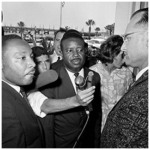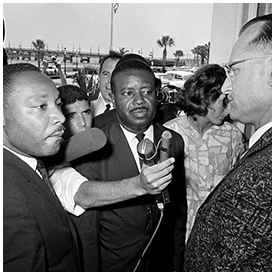
In the Spring of 1964, St Augustine would be the final stage of what was called “The Great Moral Drama” leading to the passage of the Civil Rights Act of 1964. Historic City News remembers the impact of Martin Luther King, Jr. on the Civil Rights movement in St. Augustine, aided by this compilation from the St. Johns Cultural Council.
While the city of St. Augustine was gearing up for its 400th anniversary, tensions rose as the topic of racial segregation came to the forefront and began to make headlines. National media covered stories of non-violent activists being attacked by the KKK then beaten and arrested by local law enforcement. Citizens feared for their lives and the homes of those involved were shot up and firebombed.
Following the brutality at Klan rallies and wrongful convictions of assault, activists requested the help of the Southern Christian Leadership Conference to organize sit-ins and peaceful protests. Dr. King arrived in St. Augustine on May 18, 1964, where he began working with local activists, like Dr. Robert B. Hayling, to lead the charge to end segregation.
He used the rectory at St. Benedict the Moor Church — the city’s first parish to serve African-American Catholics — in the Lincolnville neighborhood to plan marches and demonstrations that would play a significant role in the passage of Civil Rights legislation. Listed on the National Register of Historic Places, the school building, church, and rectory can be seen at 82 Martin Luther King Avenue.









On June 12, 1964, Dr. King was arrested — his only arrest in Florida — on the steps of the Monson Motor Lodge when he asked to be served at the whites-only hotel restaurant. He was taken to the St. Johns County Jail where he wrote to Rabbi Israel Dresner of New Jersey, encouraging rabbis to assist in the St. Augustine movement. On June 18th, two crucial moments in Civil Rights history would unfold at the hotel.
At the Monson Motor Lodge entrance, sixteen rabbis prayed after being refused service in the hotel restaurant. Owner James Brock reportedly pushed the kneeling rabbis toward police to be arrested. This resulted in the largest mass arrest of rabbis reported in US history to this day. Rabbi Israel “Sy” Dresner died last week on January 13, 2022, at the age of 92-years-old.
Later, the infamous incident of Brock pouring muriatic acid into the pool with a small group of protestors would occur. The image of horrified swimmers would make global headlines, influencing lawmakers to vote in favor of the Civil Rights Act of 1964.
While beaches were legally desegregated, Florida’s public beaches were still mostly off-limits to Black residents and visitors. Wade-ins began on local beaches on June 17, but one of the largest and most violent demonstrations took place at St. Augustine Beach on June 25, 1964. The Miami News reported hundreds of white segregationists “screaming and flailing” at African Americans in the “city’s worst outbreak of racial violence.”
At least 45 injuries were reported with 15 hospitalizations while white residents forced many of the demonstrators into the water, some nearly drowned. Police officers stormed the water while wielding batons, dragged Black protestors from the water, and arrested dozens. Images of the Florida Highway Patrol breaking up the riot in the water in full uniform is among one of the most circulated of the entire St. Augustine Movement.
All of this unfolded in front of the St. Augustine Beach Hotel which was added to the National Register of Historic Places on January 11, 2022, for its national importance as part of the St. Augustine Civil Rights Campaign. Wade-in protests continued until July 1, 1964, the day before President Lyndon B. Johnson signed the Civil Rights Act into law.
Discover more from HISTORIC CITY NEWS
Subscribe to get the latest posts sent to your email.




